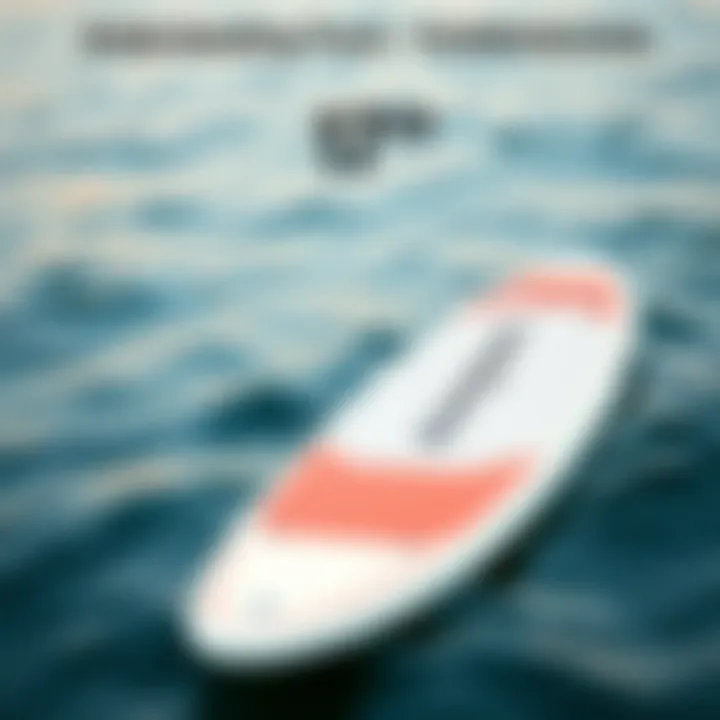Sizing Your Stand Up Paddle Board: A Complete Guide


Intro
Selecting the right stand up paddle board (SUP) isn’t just about picking something that looks cool. It’s an intricate dance of balancing your unique body type, skill level, and intended use. Many paddlers overlook the significance of size, but when you consider that the right board can enhance your experience on the water, the importance of this decision becomes apparent. Everyone wants to glide smoothly across the water, but not everyone knows how to choose the board that fits like a glove.
In this article, we’ll journey through the essential dimensions—length, width, thickness, and volume—that influence how a paddle board handles on the water. By the time you’re done reading, you’ll not only understand how to size your board but also appreciate nuances that lead to better performance and enjoyment.
Gear and Equipment
When it comes to the gear you will need, there’s a lot more to consider than just the board itself. An understanding of the latest technology and supplementary equipment can ensure that you make informed choices in enhancing your paddling experience.
Latest Surfboard Technologies
The paddleboarding world has seen innovation that makes riding easier, more enjoyable, and even eco-friendly. Today, you’ll find boards made with materials designed to be both lightweight and durable. For instance, inflatable SUPs, made from military-grade PVC, are taking the scene by storm due to their portability without sacrificing performance. Also, boards with rocker profiles, or contour designs, have varying degrees depending on the intended style—flat for stability and thinner curves for speed and maneuverability.
Investing in technology might be a little pricier, but in the long run, it could make a world of difference on the water.
Essential Accessories for Every Surfer
While the paddle board is the star of the show, accessories play a supporting role that shouldn’t be underestimated. A quality paddle, for instance, crafted out of lightweight materials can make paddling much more efficient, reducing fatigue significantly. Other essential gear includes:
- Leash: Prevents your board from drifting away if you fall off.
- Safety Vest: Always a good idea for added buoyancy, especially for beginners.
- Dry Bag: Keeps your belongings safe and dry while you’re out on the water.
- Rash Guard: Protects you from sunburn and rashes.
Sizing Considerations
Choosing the right size involves considering various factors that influence your SUP experience.
Board Length
Longer boards provide better straight-line tracking, which can be advantageous for touring or racing, but can feel unwieldy for beginners. A shorter board offers more maneuverability and is typically favored for surfing waves.
Board Width
Width impacts stability. Wider boards are generally more stable, making them good for beginners or activities like yoga on water. Meanwhile, a narrower board would glide faster through the water, making it more suitable for those looking for speed.
Thickness and Volume
Thickness also comes into play, as it contributes to a board's buoyancy and stability. A thicker board will float better, which is ideal for larger paddlers. Understanding volume ratios helps in selecting a board that won’t sink when you’re on it.
Finale
Choosing a stand up paddle board is more than just a whim; it’s about making a commitment to your enjoyment and proficiency on the water. By considering aspects such as length, width, thickness, and accessories, you not only craft a solid foundation for your paddling journey but also enhance your connection with one of nature's most soothing environments. Remember, the right board fits like a well-designed glove, and with the right size, you’re bound to make waves.
"A paddle board is not just a mode of transportation; it’s your canvas on water, shaping adventures in every stroke."
For avid paddlers looking to dive deeper into the technical aspects, resources like Wikipedia and Britannica can provide further insights.
Understanding Stand Up Paddle Boarding
Stand up paddle boarding has carved out a unique niche in the realm of water sports. It’s one part adventure, one part exercise, and a sprinkle of tranquility that draws enthusiasts from all walks of life. The importance of grasping the fundamentals of stand up paddle boarding lies not just in the mechanics of balancing on a board, but also in understanding how it can enhance your relationship with nature and your own well-being.
Overview of Stand Up Paddle Boarding
At its core, stand up paddle boarding, or SUP, involves standing on a board and propelling yourself forward using a paddle. This simple yet effective design allows paddlers the flexibility to navigate various water conditions, from serene lakes to the swells of ocean waves. The combination of physical challenge and soothing surroundings makes it a favored choice among outdoor enthusiasts.
While it may seem straightforward, there’s a fair bit of finesse involved. Balance plays a critical role; everyone, from a novice to a seasoned pro, can encounter challenges when it comes to maintaining equilibrium on the water. Moreover, understanding paddle mechanics and correct posture can make all the difference in performance and safety. Essentially, it’s about finding your groove on the board and syncing with the rhythm of the water.
Another point to think about is the social aspect. Most folks tend to gravitate towards groups, making SUP a communal experience. Whether it's embarking on a relaxed float with friends or participating in a competitive race, there's a unique camaraderie that forms when paddling alongside others.
History and Evolution of SUP
Tracing back the roots of stand up paddle boarding leads us to the ancient cultures of Polynesia. It’s a safe bet that these early sea travelers were among the first to utilize boards for transport and fishing, standing while navigating their canoes. Fast forward to the late 20th century, the practice took a modern twist in the 1960s when surf instructors in Hawaii began using large boards to engage their students while catching waves. This adaptation helped weed out the prevalent chaos of crowded beaches, allowing instructors to maintain a better vantage point.


As time progressed, the sport began to attract more attention, leading to its emergence as a formal activity in the early 2000s. Since then, a variety of board types have evolved, designed specifically for different styles and purposes, including racing, surfing, and leisure paddling. Today, manufacturers offer a dizzying array of options tailored to individual needs, mixing materials, shapes, and sizes to cater to any paddler’s preferences.
The Importance of Size in SUP
Choosing the right size for your stand up paddle board (SUP) is not just about convenience; it's a matter of getting the desired performance and ensuring your safety on the water. The dimensions of the board—its length, width, and thickness—play a crucial role in how it performs in various conditions. A well-sized board enables a smoother ride, improves balance, and ultimately enhances the overall experience. If you're looking to boost your skills or simply enjoy a more leisurely paddle, understanding these sizing nuances is essential.
Impact of Board Size on Performance
The size of your paddle board has a critical impact on its performance, which can vary based on the intended activity. For instance, longer boards often glide faster and track better in a straight line, making them favorable for touring or racing. Shorter boards can be more maneuverable, ideal for surfing waves, but offer less stability.
Length
An important measurement, the length of the board affects speed and tracking. Most touring boards range from 12 to 14 feet, while recreational boards can be between 10 and 11 feet. A common mistake is selecting a board that’s too short for distance paddling, which can lead to fatigue and a less enjoyable experience.
Width
The width of the board also comes into play. Generally, wider boards are more stable, which is great for beginners or for activities like yoga on a paddle board. But narrower boards cut through water more efficiently, making them suitable for advanced paddlers aiming for speed. These two factors create a balance: you may find that a wider board provides a stable introduction before you progress to sleeker options.
Thickness and Volume
The thickness of your board influences its buoyancy. Thicker boards typically have a greater volume, supporting heavier weights without sinking. This can be especially important for heavier paddlers or when carrying extra gear. An underestimation of weight supported may lead to an uncomfortable ride—nobody wants their board bobbing like a cork!
Safety Considerations
Safety is paramount in any water sport, and the size of your SUP can significantly affect your well-being on the water. An ill-suited board could lead to dangerous situations. Consider the following:
- Stability: A board that’s too narrow for your skill level may tip or wobble, increasing your chances of falling into the water. This is especially true for inexperienced paddlers who may not yet have mastered balance.
- Weight Capacity: Ignoring the board’s weight capacity can have dire consequences. Always check if the board can accommodate not only your weight but also any additional equipment you plan to bring. It’s better to be cautious than find yourself struggling against the water's currents.
- Weather Conditions: An incorrectly sized board can amplify the impact of wind and waves. If you venture out in choppy waters without the right dimensions, your board might respond unpredictably.
Always choose a board that fits your experience level and anticipated conditions. A fitting SUP enhances enjoyment and minimizes risks.
Stretching your understanding and adapting to your needs can elevate your water adventures. It can be the difference between a harmonious paddle and a frustrating experience. The right size not only supports you physically but also boosts your confidence as you navigate the water.
Factors Influencing Board Size
When it comes to stand up paddle boarding, size is of the essence. But what exactly does it mean to select the right dimensions for your board? Factors that can influence board size extend beyond mere numbers; they encompass a variety of elements that shape the experience on the water. Board size impacts stability, speed, and maneuverability, all of which correlate directly to the skill and preferences of the paddler. Thus, determining the right sizing algorithm isn't just a matter of picking a number—it's about matching that number to your unique specifications.
Skill Level: Beginner vs. Advanced
The skill of a paddler plays a pivotal role in the sizing of their board. A beginner often seeks stability and comfort. Wider boards tend to provide that. A wider stance makes balancing much easier for those still finding their sea legs. For instance, if you're new to this, boards around 30 inches in width can be a good fit. They feel like a solid base under your feet while you learn the ropes.
On the other hand, advanced paddlers look for performance and speed. They usually opt for narrower boards which can slice through the water more effectively. If you’re experienced, a board around 27 inches wide could afford that necessary speed without compromising control too much.
Remember, while wider boards are more forgiving for beginners, they might not serve advanced riders well. Nothing beats the feeling of gliding effortlessly on your own chosen vessel, irrespective of skill level.
Body Weight and Height
Another major consideration when sizing your paddle board is the paddler's body weight and height. The volume of a board—essentially its buoyancy—needs to match the paddler's weight. If the board is under-sized, buoyancy might falter, making the experience less than enjoyable. Generally, weighing between 150 and 225 pounds might suggest a board with a minimum volume of 130 to 200 liters.
Height also affects how you balance on the board. Taller paddlers may require longer boards to gain optimal stability. As a thumb rule, someone above six feet might prefer a board that is 10'6" long or more. It's like finding a pair of shoes; a snug fit works wonders, but too tight or too loose can lead to discomfort.
Intended Use: Recreation vs. Competition
It's vital to think about how you plan to use your paddle board. Recreational paddlers often prioritize stability and comfort. These boards are generally broader and boast more volume to help absorb choppy water. Folks planning a relaxing day on the water cruising around might reach for boards designed for leisure, typically longer and wider for comfort.
In contrast, competition-focused paddlers seek speed and maneuverability. Race boards are longer, typically exceeding 14 feet, and thinner, allowing for quick slicing through the waves. These boards are designed for efficiency rather than leisurely strolls. If you’re eyeing competitions, well, it’s like trading in your family sedan for a sports car—performance is key.
In summary, picking the right size board goes beyond numbers—it reflects your individual skill, body characteristics, and usage preferences. Adequate sizing can elevate your paddling experience from ordinary to extraordinary.
Understanding these factors can align your choice with your aspirations on the water. Don't take sizing lightly; the right fit can open up an entirely new world of paddle boarding adventure!
Key Measurements for Sizing SUPs
Choosing the right size for your stand up paddle board is not just a matter of aesthetics; it plays a critical role in your overall experience on the water. Board measurements can significantly affect performance, stability, and your ability to execute certain paddling techniques. Understanding the importance of length, width, thickness, and volume will help you select a board that best meets your needs and enhances your time on the water.


Board Length and Its Implications
When it comes to paddle boards, length is a pivotal measurement that directly influences your paddling performance. Longer boards generally offer straight-line speed, making them ideal for touring and long-distance paddling. Conversely, shorter boards facilitate maneuverability, which is essential for surfing and navigating tight spaces.
For instance, if you enjoy leisurely paddles on calm lakes, a board between 10 to 12 feet might suit you well. On the flip side, those aiming to catch waves will find that boards around 8 to 9 feet in length allow for more agile turns and quicker response times. Keep in mind your height, weight, and paddling experience play into this decision. A longer board can support more weight but may also require more effort to turn.
Width: Stability Versus Speed
Width is another measurement that can completely change your paddling game. Wider boards are typically more stable, which can be beneficial for beginners or those carrying extra gear. Think of wide boards like a sturdy platform—ideal for standing and maintaining balance. A width of about 30 inches or more can provide the stability for yoga or leisure paddling.
On the other hand, narrower boards, those under 30 inches, are designed for speed and slicing through water. If you’re venturing into competitive racing or faster paddling, you might want to aim for a slimmer profile. However, be aware that a narrow board can feel tippy if you're not accustomed to it. Finding the sweet spot between stability and speed is crucial, and often comes down to personal comfort and intended use.
Thickness and Volume Considerations
Thickness and volume are the unsung heroes of paddle board sizing. Think of thickness as the board's buoyancy—how much weight it can support without sinking. A thicker board generally provides more volume, which can enhance stability and support heavier riders. For someone weighing around 200 pounds, a board with a volume of over 180 liters might be necessary for that buoyant ride.
However, thickness also influences the board's overall glide through the water. Thinner boards tend to be sleeker and cut through waves more efficiently. This is where understanding your own needs is vital. If you’re more involved in fitness paddling and want to crank up the speed, you might lean toward a thinner style. On the other hand, for casual outings or recreational use, opt for a thicker board that can handle varying conditions.
"Choosing your paddle board size is about balancing several factors: stability, performance, and your own paddling style. Find what fits you best."
Understanding these measurements—length, width, thickness, and volume—will give you a clearer picture of what will work for you. When you’re equipped with the right knowledge, selecting a paddle board becomes less of a gamble and more of a satisfying choice that leads to better paddling experiences.
Style of Paddling and Board Sizing
Choosing the right paddle board isn't just about grabbing the flashiest design or the latest color. One of the most critical factors in selecting a board is understanding how your style of paddling influences sizing. From leisurely paddles along serene lakes to adrenaline-pumping surf sessions, your intended use can greatly inform the board's dimensions and features. Before diving in, it’s essential to recognize that the right size can enhance performance, safety, and, most importantly, your overall experience on the water.
Touring and Fitness Paddling
When it comes to touring and fitness paddling, size largely reflects how efficiently you can glide over water. Generally, a longer board is your best bet here. A length between 12 to 14 feet typically offers a decent balance, allowing for straight-line speed while maintaining stability. The reasoning behind this is akin to riding a bicycle; the longer the bike frame, the straighter it goes, so to speak.
A broader board can provide extra stability, which might be particularly beneficial for newcomer paddlers. Those who are serious about fitness and efficiency, however, often look for a board between 28 to 30 inches in width. This narrower profile allows for quicker strokes and enhances speed.
Additionally, look for features like a pointed nose, which helps in slicing through the water and reduces drag, making you feel almost like you have a jetpack on when you're gliding along.
Wave Riding and Surfing Boards
Wave riding flips the script on sizing, as balance and maneuverability take precedence. Here, shorter boards shine—usually between 8 to 10 feet. These shorter lengths allow for rapid turning and a snappier performance, which is crucial when riding ocean swells.
Additionally, the ideal width for surfing boards tends to be more varied, where widths ranging from 28 to 32 inches can suit different styles. For instance, a wider board might be advantageous for a beginner who needs more stability, while a narrower design can cater to advanced paddlers seeking those exhilarating, tight turns.
Your board's rocker—how curved the board is from nose to tail—also dramatically affects performance in waves. A board with a considerable rocker will help you to get up on those waves quicker and navigate through the choppy waters.
Race Boards and Competitive Sizing
Race boards are another kettle of fish altogether, focusing heavily on speed and performance. These boards often eclipse the lengths of other styles, typically ranging from 14 feet to 18 feet for elite racers. The length serves to maximize speed, as it increases the momentum and minimizes drag.
Width matters as well; unlike fitness and touring boards, a narrower profile—often between 23 to 27 inches—is optimal for reducing resistance. For competitors, every inch counts, and a board that’s too wide can be a hindrance during a race.
Interestingly, thick boards can sometimes provide volume needed to support larger paddlers, but here the balance between thickness and weight distribution becomes key. A well-crafted race board caters not only to the racer’s physique but also to their technique, making sure every stroke feels as effortless as a breeze.
In essence, your style of paddling plays a huge role in what kind of board will suit you best. Whether you’re touring, wave riding, or racing, the right size board can significantly elevate your performance and enjoyment while paddling.
Understanding these different styles of paddling isn't merely a point of interest; it's essential for making an informed decision when sizing your paddle board. The more criteria you consider, the better your chances of finding a fit that feels like a glove as you carve through the water.
Testing a Paddle Board
Selecting the right paddle board involves more than just picking what looks good on the rack. Testing a stand-up paddle board (SUP) is a critical step that can significantly enhance your overall paddling experience. By getting a feel for the board before buying, you ensure that it not only fits your needs but also feels right under your feet. The process of testing can provide valuable insights into how size, shape, and design impact performance and comfort on the water.
How to Evaluate Size Before Purchase
When you’re about to make a significant investment in a paddle board, the last thing you want is buyer's remorse. Evaluating the size of a SUP before purchase can save you a world of trouble. Here are some hands-on strategies to consider:
- Test Ride: Most shops or rental places offer demo days where you can try before you buy. It's worth the trip. Use this opportunity to feel how the board glides through water. Pay attention to how its dimensions and design influence stability and maneuverability.
- Consider Your Weight: A general rule of thumb is that board thickness and volume should correspond with your body weight. Heavier paddlers might want increased volume for buoyancy. If you're not sure, try different boards and see which ones feel more stable.
- Adjust for Your Skills: Beginners often find wider, shorter boards easier to balance on. If you're just starting, a longer and narrower board might feel less forgiving. Evaluate the board's behavior as you paddle; this can indicate whether the size is appropriate for your level.


"What feels comfy for one person might be a chore for another. Always trust yer own instincts during a test ride."
The Importance of Trial and Error
The idea of trial and error often evokes a sense of clumsiness. However, in the world of SUP, this method can lead to discovery and satisfaction. Understanding what works for you might take a bit of fiddling around. Here’s why being flexible is essential:
- Find Your Sweet Spot: Every paddler is different, and what suits one might not fit another. Trying out various sizes and styles allows you to discover what you genuinely enjoy. A board that looks amazing in a photo may feel awkward when you're on the water.
- Adapt to Local Conditions: Water bodies vary significantly. For instance, a board that performs great in calm lakes may not be suitable for choppy seas. Testing different boards in varied conditions prepares you for what you'll face once you head out.
- Listen to Feedback: Ask other paddlers what they think about the board you’re trying. Local knowledge is hard to beat. Their personal experiences can provide context and insight about how similarly designed boards perform.
For further insights, check out resources like Reddit's Paddle Board Community or local outdoor shops that may offer demo sessions and expert advice.
Common Sizing Mistakes
When choosing a stand up paddle board, small errors can snowball into significant issues, negatively affecting your time on the water. Navigating the sea of options is already confusing; add sizing blunders into the mix, and it’s like trying to paddle upstream without a boat. Understanding the common pitfalls can help you avoid costly mistakes that could hinder your performance and enjoyment.
Overestimating Board Size Needs
Many new paddlers make the mistake of overestimating their board size requirements. The thought process often is that a bigger board will equate to more stability and performance. However, this line of thinking can lead to problems. Boards that are too large can be cumbersome, dragging more than they glide, making it hard to navigate in choppy waters.
A common misconception is that height dictates how long or wide a board should be. Sure, taller individuals might feel more comfortable on something larger, but technique and skill play a much bigger role. For instance, an inexperienced paddler might find themselves struggling with a broader board, which can stymie their paddling efficiency. Conversely, experienced paddlers may thrive on a smaller, more agile board that fits their skills and style.
Choosing the right size requires a bit of homework. Most manufacturers provide thorough sizing guides based on weight and intended use. Here’s some quick tips to avoid overestimating:
- Do Your Research: Study manufacturer recommendations thoroughly.
- Consider Skill Level: Understand that your level of proficiency will significantly influence board choice.
- Balance Stability and Speed: A board that is too bulky may offer comfort, but a balance of speed and stability is necessary for most conditions.
Remember, bigger isn't always better! Select a board that complements your skillset.
Neglecting Personal Preferences
Another frequent mistake is overlooking personal preferences when selecting a paddle board. Riders come in various shapes and sizes, with unique style preferences and priorities. Like choosing a pair of shoes, it often comes down to what feels right. Some folks might adore speed on the water, while others favor leisurely paddles while taking in the scenery.
By neglecting what feels comfortable, paddlers can end up with a board that doesn’t suit their vibe, leading to frustration and diminished experiences. Opting for aesthetic appeal or following trends isn’t a recipe for success. Instead, ask yourself:
- What’s my primary purpose? Are you racing, touring, or simply enjoying lazy afternoons on the lake?
- Do I prioritize speed or stability? Knowing this will steer you towards the right shape and size.
- How often will I use it? If you plan to paddle frequently, a personalized fit will enhance your enjoyment.
Ultimately, understanding your personal style will lead to a much more enjoyable paddle experience. Dive into community forums or local SUP clubs, and don’t be shy in asking seasoned paddlers for their insights—sometimes, firsthand experiences with various boards can reveal what’s best for you. Let's face it—optimum performance and comfort stem from knowing what suits you instead of what seems popular at the moment.
Further Resources
By avoiding these common sizing mistakes, you empower yourself to choose a board that complements your skills and preferences, leading to a far more enjoyable experience on the water.
Resources for Further Guidance
Finding the right stand up paddle board can often feel like navigating through a maze. That's where resources for further guidance come into play. These resources not only provide additional information but also help you make informed decisions, ensuring that you're not just grabbing any board that looks flashy. Utilizing these tools can mean the difference between a fulfilling experience on the water and one filled with frustration.
Online Tools for Sizing
In today's digital age, countless online tools are designed to assist you in sizing your paddle board correctly. Many manufacturers and outdoor retailers offer online sizing calculators tailored to your specific needs. Here's why leveraging these tools is a smart move:
- Customization: You can input your personal details like height, weight, and paddling style, which helps narrow down your options efficiently.
- Comparison Features: Some sites allow you to compare different models side-by-side, highlighting their specifications and user ratings.
- User Reviews: Reading what fellow paddlers have to say about a particular board can shed light on real-world performance, which might not be evident from the spec sheet alone.
A few recommended resources include:
- REI Paddle Board Sizing Guide: This guide offers tailored suggestions based on various user inputs.
- Boardworks: Their sizing tool provides a simple interface to help identify the best size for your weight and intended use.
Utilizing these online tools not only saves you time but also enhances your understanding of what you need from your paddle board.
Consulting Experts and Community
Sometimes, the best guidance comes from those who have experienced the thrill of paddling firsthand. Consulting experts in the field, whether through local shops or online forums, can provide valuable insights you won't find on any website. Here’s what to look for:
- Local Shops: Consider visiting your local SUP shop where experts can offer personalized advice. They often have years of experience and can address specific questions you might have.
- Community Forums: Websites like Reddit or dedicated Facebook groups offer a wealth of knowledge from seasoned paddlers. Members often share their experiences, tips, and tricks. This can be especially helpful for niche concerns or advanced techniques.
- Workshops and Classes: Many areas offer paddle boarding classes or workshops that include sizing advice as part of the curriculum. This hands-on experience can be invaluable.
Engaging with the paddle boarding community not only enhances your knowledge but can also make the whole journey feel less daunting.
"The joy of paddling is always better when shared with others who love the sport as much as you do."
In summary, combining online tools with expert insights creates a multifaceted approach to choosing the right paddle board. Whether you're new to the sport or a seasoned paddler, these resources can enhance your paddling experience while ensuring you get the right fit.







